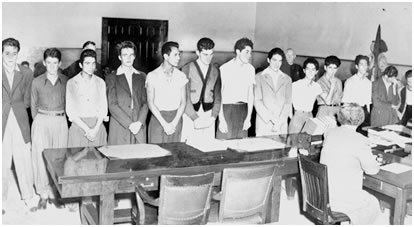 | ||
The "Sleepy Lagoon murder" was the name that Los Angeles newspapers used to describe the death of José Gallardo Díaz, who was discovered unconscious and dying on a road near a swimming hole (known as the Sleepy Lagoon) in Commerce, California on the morning of August 2, 1942.
Contents
Díaz was taken by ambulance to Los Angeles County General Hospital, where he died shortly after, never having regained consciousness. The hospital autopsy showed that he was inebriated from a party the previous night and had a fracture at the base of his skull. This might have been caused by repeated falls or an automobile accident. The cause of his death remains a mystery to this day. However, Los Angeles Police were quick to arrest 17 Mexican-American youths as suspects. Despite insufficient evidence, the young men were held in prison, without bail, on charges of murder. The trial ended on January 13, 1943, under Judge Charles W. Fricke. Nine of the defendants were convicted of second-degree murder and sentenced to serve time in San Quentin Prison. The rest of the suspects were charged with lesser offenses and incarcerated in Los Angeles County Jail. The convictions were reversed on appeal in 1944. The case is considered a precursor to the Zoot Suit Riots of 1943.
Sleepy Lagoon was a reservoir beside the Los Angeles River that was frequented by Mexican-Americans. Its name came from the popular song "Sleepy Lagoon", by big band leader and trumpeter Harry James. The reservoir was located near the city of Maywood at approximately 5500 Slauson Avenue in Bell, California.
Death
With the internment of Japanese Americans, racial tension in California shifted toward the Mexican-American community and, spurred by the media, a grand jury headed by E. Duran Ayres was appointed by the City of Los Angeles to investigate an alleged "Mexican Crime Wave."
The morning of August 2, 1942, José Díaz was found unconscious and later died in the hospital. The autopsy revealed that Díaz was intoxicated and that death was the result of blunt head trauma. Despite one medical examiner stating that the injuries were consistent with being hit by a car, 20-year-old Henry Leyvas and 24 members of what the media termed "the 38th Street gang" were arrested for allegedly murdering Díaz. They suspected that rival Pachuco gang fights were the cause of Díaz's death.
In response to the alleged murder, the media began a campaign calling for action against "zoot suiters" which led police on August 10 to conduct a roundup of 600 Latinos who were charged with suspicion of assault, armed robbery, and related offenses; 175 were eventually held for various crimes.
Criminal trial
The resulting criminal trial is now generally viewed as lacking in the fundamental requirements of due process. Seventeen Latino youths were indicted on the murder charges and placed on trial. The courtroom was small and during the trial the defendants were not allowed to sit near, or to communicate with, their attorneys. None of those charged were permitted to change their clothes during the trial by order of Judge Fricke at the request of the district attorney on the grounds that the jury should see the defendants in the zoot suits that were "obviously" only worn by "hoodlums". Every time a name was mentioned by a witness or the district attorney, regardless of how damning the statement was, the named defendant was required to stand up. Judge Fricke also permitted the chief of the Foreign Relations Bureau of the Los Angeles sheriff's office, E. Duran Ayres, to testify as an "expert witness" that Mexicans as a community had a "blood thirst" and a "biological predisposition" to crime and killing, citing the culture of human sacrifice practiced by their Aztec ancestors.
Activist involvement
The Sleepy Lagoon Defense Committee was a community organization made up of Los Angeles community members and activists who came together to support the defendants. The SLDC (Sleepy Lagoon Defense Committee) was also known as The Citizens' Committee for the Defense of Mexican-American Youth. The committee was labeled a Communist front organization by the California state legislature's Joint Fact-Finding Committee on Un-American Activities headed by Jack Tenney. Some SLDC members included: Alice McGrath, Josefina Fierro de Bright, Josefa Fierro, Maria Alvez, Luisa Moreno, Dorothy Healey, LaRue McCormick, Lupe Leyvas, Henry Leyvas, Doc Johnson, Frank Lopez, Bert Corona, and Gray Bemis. The SLDC's mission was to mount a civil rights crusade so that "these Mexican-American defendants might have a full measure of justice under the Constitution". The SLDC utilized their contacts with influential community members to promote their cause and for fund-raising purposes to be able to support their cause. After Judge Fricke's verdict in January, the Mexican-American youths were imprisoned without evidence and because they were "Mexican and dangerous", ipso facto. The Mexican American community was outraged and several attorneys challenged Judge Fricke's decisions: George Shibley, Robert Kenny, Clore Ware, Ben Margolis, John McTernan, Carey McWilliams, and several others. Together they hoped to remind the American society that minorities had the right to testify in court and have impartial jury trials. McWilliams noted that a few months earlier over 120,000 Japanese Americans were detained and interned in detention camps, and later argued that there were common links between the Japanese-American internment and the anti-Mexican response in the Sleepy Lagoon case. From 1943 through 1944, the state anti-Communist Tenney Committee subpoenaed and investigated the members of the Defense Committee in an attempt to uncover Communist ties.
Reversal
In October 1944, the state Court of Appeals unanimously decided the evidence was not sufficient to sustain a guilty verdict. It reversed the 12 defendants' convictions, in the case of People v Zammora 66 Cal.App.2d 166. The appeals court also criticized the trial judge for his bias and mishandling of the case.
